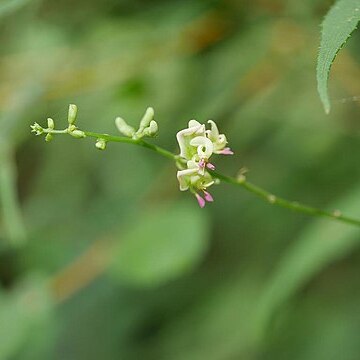Herbs, twining. Root tuber spherical or ovoid. Stems slender, sparsely hirsute. Leaves pinnately 3-7-foliolate, 10-25 cm; stipules linear-triangular, to 4 mm, very inconspicuous; petiole 3-6.6 cm, glabrous; stipels inconspicuous; petiolules sometimes hairy; leaflets ovate or rhomboid-ovate, 3-7.5 × 1.5-4 cm, papery, abaxially sparsely hirsute, adaxially glabrous, base broadly cuneate or rounded, apex acute, mucronate. Raceme axillary, 6-26 cm; bracts and bracteoles minute, lanceolate, ciliate, deciduous. Calyx bowl-like, shallowly 2-lipped. Corolla yellowish green or light green; standard orbicular, 1-1.5 cm; wings almost half as long as standard; keels much longer than standard, curled into semicircle. Ovary sparsely shortly hairy; style coiled, glabrous. Legume light brown, ca. 8 × 0.6 cm, glabrous, compressed. Fl. Jun-Aug, fr. Sep-Oct.
More
A herb. It is a climbing plant. It keeps growing from year to year. It has tuberous roots. The small branches have a few soft hairs. The leaves have leaflets along the stalk. There are 3-7 leaflets. They are oval or sword shaped. They are 3-7 cm long by 2 cm wide. The flowers are greenish-white. They are 6-8 mm long. They are in groups 6-27 cm long at the end of branches. The fruit are narrow pods 7-8 cm long and 5-6 mm wide.
Can be grown by seedlings. Seeds needs soaking.

